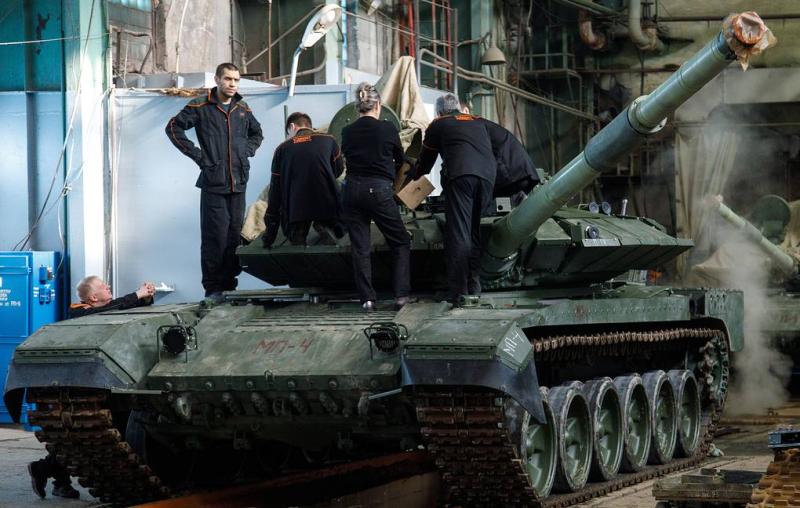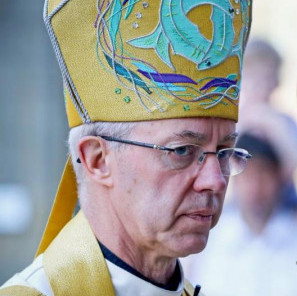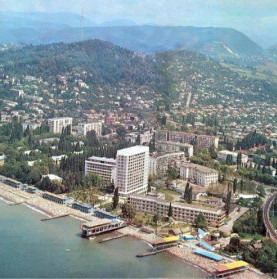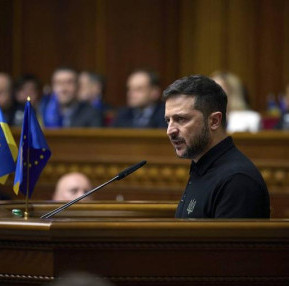
© Marina Moldavskaya/TASS
Top stories from the Russian press on Thursday, September 15th, prepared by TASS
Izvestia: Russia to reinforce its western flanks with T-90M tanks
Russia’s Western Military District will get more third-generation T-90M tanks, Defense Ministry officials told Izvestia. A fundamental decision has already been made, and the timeframes of the deployment of Russia’s latest combat vehicles will depend on how the state defense order is carried out. The tanks will be used to rearm the existing military contingents and will also be delivered to newly-deployed military units.
Russia started building up forces on its western flanks over the last decade. In May 2021, Russian Defense Minister Sergey Shoigu said around 20 new units would be deployed in the Western Military District by January 1, 2022. He said that was in response to activities by the US-led NATO which had increased the intensity of flights and the presence of warships near Russia’s borders. A year later, in May 2022, Russia’s defense chief said 12 new military units would be deployed on the country’s western flanks, citing increasingly rising threats.
It is obvious that some of the new units will reinforce Russia’s ground forces, while others will bolster the air defense forces and aerospace troops, Alexey Leonkov, a military expert, told Izvestia. Though it is not clear yet what military units will be deployed, ground forces simply cannot do without armored units, he said. "One should realize that the West will use NATO tanks, Leclercs, Leopards and Abrams, not Soviet machines, like now, against us in a potential conflict. And the T-90 is unrivaled against those, even though it has never been engaged in clashes yet," the expert said.
Another military expert, Vladislav Shurygin, told Izvestia that tanks had been one of the main weapons on the battlefield of late. "The T-90M is a very powerful machine, considered one of the best in the world. And Russia needs those on its western flanks. However, in a conflict, Russia will also fight in its southern areas, where there are forest steppes and steppes, and tanks work best there. The deployment of new military units in the Western Military District is in response to NATO’s buildup near Russia’s borders. We cannot afford having the same amount of troops as before," he concluded.
The T-90M is Russia’s latest tank among those in service. Based on its characteristics, it is almost identical to the T-14 Armata, "the tank of the future," being only slightly inferior to that in terms of its driving performance and armor protection. And the two have almost equal firepower. The upgraded T-90M is equipped with an improved 2A56M5-01 gun and a powerful diesel engine. The machine is equipped with the Kalina automated fire control system and the Kord-MT remotely-controlled anti-aircraft machine gun.
Nezavisimaya Gazeta: Armenia’s PM may be getting ready to cede Nagorno-Karabakh
A few hours prior to a UN Security Council meeting on the conflict between Armenia and Azerbaijan, Baku’s armed forces resumed heavy shelling at Armenian residential areas, using artillery and drones. Russian Federal Security Service vehicles were also hit. Armenian Prime Minister Nikol Pashinyan requested military assistance from Moscow and the Collective Security Treaty Organization (CSTO). Some of his statements give reason to assume that Yerevan is ready to make unpleasant concessions, provided a lasting peace is ensured.
"If they (Azerbaijan - TASS) pull their troops to where the Soviet border was, we will recognize (Azerbaijan’s territorial integrity), otherwise not. And neither the balance of power, nor the allies or whose ally is stronger matters. This is our political position that will not change," Pashinyan emphasized.
However, according to Armenian media, he said Yerevan would not sign a ‘peace treaty’ that would lead to a new war in six months. "We are ready to sign a paper for which many would scold us, or call us traitors, and the people may decide to overthrow us, but that would ensure Armenia a lasting peace," the media quoted him as saying. Though Pashinyan did not say it outright, one can assume what he meant. His rhetoric about the Soviet-era borders, the mutual recognition of territorial integrity and unpopular decisions that could result in his resignation may indicate that the Armenian premier suggests his country no longer insist on the independence of Nagorno-Karabakh, Nezavisimaya Gazeta writes. In return, Pashinyan wants inviolability of the other regions that were part of the Armenian republic in Soviet times and are now being encroached upon by Azerbaijan to build a corridor to the exclave of Nakhichevan.
In his turn, Azerbaijan’s leader Ilham Aliyev held a phone call with Emmanuel Macron, the president of France that holds the UN Security Council presidency this month. Aliyev laid the blame for the latest escalation on the Armenian leadership, saying "Azerbaijan has been taking response measures" and called on his French counterpart to consider the situation in an unbiased manner.
Neighboring Georgia and Iran raised their concerns and also said they were ready to contribute to a ceasefire, while Tehran warned it would not accept any geopolitical changes in the region. Another major regional player, Turkey, took sides with Azerbaijan, blaming Armenia for the latest conflict, saying that "is being insincere in its settlement with Azerbaijan."
Some experts say the flare-up may be in an attempt to open a new anti-Russian front. Where Georgia failed with its former autonomous areas, at least so far, it has now been brought to the zone of the conflict between Azerbaijan and Armenia, experts believe. And the reignited border conflict between Kyrgyzstan and Tajikistan indirectly confirms that an attempt is being made to overstretch Russian forces as much as possible.
The social networks in Azerbaijan and Armenia have been the bellwether of the majority of both societies. While the Azeri segment is confident that the country’s goal would be attained and that Armenia would capitulate, the Armenian segment insists that the latest flare-up does not serve Yerevan’s interests at all. By the time Nezavisimaya Gazeta had its latest issue ready for printing, news broke that Armenia’s leaders had asked the CSTO to hurry up, saying the country’s losses in clashes with Azerbaijan already amounted to 105 troops.
Rossiyskaya Gazeta: Global energy crisis may be about to start
Currently, only the EU ban on the purchase of Russian coal and the US embargo on Russian oil are fully working against Russian hydrocarbon exports. However, both restrictions are local and have not seriously affected the global market yet. From December 5, the EU embargo on Russian seaborne oil supplies will come into effect, and from February 5, a similar ban on the import of Russian petroleum products will be imposed. Exactly these measures could plunge the global energy market into a full-fledged crisis, especially if Russia brings to zero the flow of its natural gas to the European Union.
Director of the National Energy Security Fund Konstantin Simonov told Rossiyskaya Gazeta that Europe would not be left without oil. It is no coincidence that it has until December to get ready for the oil embargo. With no increase in global oil production, the EU could buy more crude from the Middle East, repurchasing it from clients in the Asia-Pacific region. On the contrary, Russian oil will be redirected eastwards, and the logistics would change completely, which would make the fuel more expensive, but would not cause any deficit yet.
Russia that exports some 2 million barrels of oil and about 1 million barrels of petroleum products per day to Europe would not be unaffected. According to an estimate by Russia’s Energy Development Center, at least half of the volume would be redirected to other markets, but the substitution would be incomplete which would lead to output reduction.
Natural gas is where Russia is strongest in the story. Unlike with oil, the country would not be able to redirect its gas exports to the east, and yet even a full stoppage of gas exports to Europe would not be fatal for Russia, Simonov assured. Of course, Russia is losing money and market share, but not to an extent that would do major damage to the country’s economy, while the European economy, specifically its steelmaking and chemical industries, would simply be destroyed when gas prices soar.
According to Simonov, there are no free volumes of gas for Europe on the market. The continent would not freeze this winter, for it is rich enough to avoid that, but the EU would pay through the nose. It would also have to compete with the Asia-Pacific region for natural gas, which would push prices even higher. Meanwhile, Russia has made it clear to the EU that it should either reconsider its anti-Russian sanctions or launch Nord Stream 2. Still, the West is not backing down, and the battle of nerves continues, Simonov concluded.
The Energy Development Center said Russia would not initiate a complete stoppage of its gas flows to Europe, at least because it has to pump gas to Serbia and Hungary, both friendly states. In theory, Russian gas exports could stop if the EU approved a price cap for Russian natural gas, but the idea is finding fewer and fewer supporters in Europe.
Vedomosti: EC plans to compel fossil fuel firms to share excess profits, curb gas consumption
According to the latest proposals from the European Commission, EU members should aim to reduce total electricity consumption by at least 10% by the end of March 2023, and power consumption should go down by at least 5% during peak hours.
However, no price cap for gas will be imposed in the EU. The EC also proposed making oil and gas companies share excess profits to redirect the funds to energy intensive industries and vulnerable households. EC President Ursula von der Leyen said that could enable the EU to raise more than 140 billion euro.
The latest proposals look more viable to Alexey Grivach, Deputy General Director of the National Energy Security Fund. And yet it would be impossible to implement some of the measures, because those have involved propaganda, the expert told Vedomosti. For example, it would be hard to administer a compulsory reduction in electricity consumption, while steps to withdraw excess profits would be strongly opposed by businesses, he warned.
Limiting gas consumption is the only measure among the EC proposals that could mitigate the energy crisis for the EU, at least partially, Deputy Director General of the National Energy Institute Alexander Frolov said. According to him, saving even 1.2 billion cubic meters could be tangible. The EU already reduced its gas consumption by 10.5% over the first eight months of 2022, he said, and the EC proposal already includes the reduced gas consumption, so the measure would not help improve the situation radically.
According to ENTSOG and Vedomosti’s calculations, Russia is currently exporting some 80 million cubic meters of gas per day to the EU. On September 15, 2021, the volume amounted to 421.7 million cubic meters, according to Gazprom.
Rossiyskaya Gazeta: MAN, Scania decide to exit Russia
European automakers MAN and Scania are leaving Russia. The producers of commercial vehicles, including trucks, will also sell their distributors, according to a statement by the major shareholder of the two, Germany’s Traton, a Volkswagen subsidiary, published on its website. Their assets are expected to be sold by the end of this year, provided there is approval from the supervisory boards of both Traton and Volkswagen and Russia’s regulators.
Both companies saw a plunge in their car sales in Russia this year. The analytical agency Autostat told Rossiyskaya Gazeta that in January-August 2022, Scania’s market share shrank by 78% from a year ago, and that of MAN plunged 77%.
Since the assets of Scania and MAN will be sold to Russian partners, Russia would not face a more severe deficit in commercial vehicles, an independent expert, Alexey Tuzov, told the newspaper. In addition, not all trucks made by Scania and MAN were blacklisted, and deliveries of some dump trucks could continue unrestricted, he said.
The departure of European brands from the Russian truck market would benefit other market players, primarily Chinese producers, Dmitry Zavyalov, Assistant Professor at Plekhanov University, told Rossiyskaya Gazeta. KAMAZ, which used to account for a third of the Russian market, increased its share to about 40% over seven months. However, it would hardly make a greater breakthrough, for the Russian automaker relies much on foreign-made components for the production of its K4-and K5-generation trucks, Zavyalov said.









